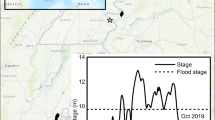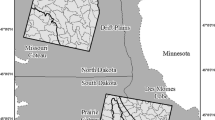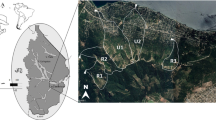Abstract
Geographically isolated wetlands (GIWs) comprise a significant portion of the wetlands in the U.S., connecting to surrounding landscapes in varying ways and providing diverse ecosystem functions. Understanding the consequences of wetland connections across space and time are crucial in understanding GIW function. We compared nutrient concentrations, litter breakdown, and associated macroinvertebrate communities from 2018 to 2019 in three wetlands connected by an intermittent flow path to agricultural fields, to three unconnected GIWs. Litter bags were constructed of two mesh sizes to reduce macroinvertebrate abundances. We observed increased breakdown with greater connection to agricultural fields, likely the result of increased nutrients such as phosphorus enhancing microbial activity. Enhanced breakdown in the connected wetlands was transient, varying between years and the degree of connection. While water quality measures did not consistently show increased nutrient levels across all connected wetlands, lower litter N:P within connected wetlands provided a broader look at nutrient subsidies. Macroinvertebrate abundance was greater in connected wetlands when connection occurred and shredder abundance was greater later during breakdown, however high variability obscured any pattern with breakdown rates. Comparing litter decomposition rates in our study to previous studies, we note that our connected wetlands functioned more similarly to flowing waters while the unconnected wetlands functioned like discrete wetlands. Future climate predictions indicate increased winter rainfall for this region which will increase the degree and frequency of hydrologic connection and associated nutrient transport. Understanding how the extent of connection alters wetland function is important in understanding the roles wetlands play in landscape ecosystem function.






Similar content being viewed by others
Availability of data and material
The data is available from the corresponding author on reasonable request.
Code Availability
The R code is available from the corresponding author on reasonable request.
References
Atkinson CL, Golladay SW, First MR (2011) Water Quality and Planktonic Microbial Assemblages of Isolated Wetlands in an Agricultural Landscape. Wetlands 31:885–894. doi: https://doi.org/10.1007/s13157-011-0203-6
Aldous A, McCormick P, Ferguson C et al (2005) Hydrologic regime controls soil phosphorus fluxes in restoration and undisturbed wetlands. Restor Ecol 13:341–347. doi:https://doi.org/10.1111/j.1526-100X.2005.00043.x
APHA (2017) Standard method for the examination of water and wastewater. American Public Health Association, Washington DC
Bates D, Maechler M, Bolker B, Walker S (2015) Fitting Linear Mixed-Effects Models using lme4. J Stat Softw 67:1–48. doi: https://doi.org/10.18637/jss.v067.i01
Battle JM, Golladay SW (2007) How hydrology, habitat type, and litter quality affect leaf breakdown in wetlands on the gulf coastal plain of Georgia. Wetlands 27:251–260
Battle JM, Golladay SW (2001) Hydroperiod influence on breakdown of leaf litter in cypress-gum wetlands. Am Midl Nat 146:128–145
Benfield EF (2006) Decomposition of leaf material. In: Hauer FR, Lamberti (eds) Methods in stream ecology. Academic Press, Sand Diego, California, pp 711–720
Botello G, Golladay S, Covich A, Blackmore M(2013) Immature mosquitoes in agricultural wetlands of the coastal plain of Georgia, U.S.A.: Effects of landscape and environmental habitat characteristics. Ecological Indicators 34:304–312. doi: https://doi.org/10.1016/j.ecolind.2013.05.018
Capps KA, Rancatti R, Tomczyk N et al (2014) Biogeochemical Hotspots in Forested Landscapes: The Role of Vernal Pools in Denitrification and Organic Matter Processing. Ecosystems 17:1455–1468. doi: https://doi.org/10.1007/s10021-014-9807-z
Cohen MJ, Creed IF, Alexander L et al(2016) Do geographically isolated wetlands influence landscape functions? Proceedings of the National Academy of Sciences 113:1978–1986. doi: https://doi.org/10.1073/pnas.1512650113
Craft CB, Casey WP (2000) Sediment and nutrient accumulation in floodplain and depressional freshwater wetlands of Georgia. USA Wetlands 20:323–332. doi: https://doi.org/10.1672/0277-5212
Cuffney TF, Wallace JB (1987) Leaf litter processing in Coastal Plain stream and floodplains of southeastern Goergia, USA. Arch für Hydrobiol 76:1–24
Day FP Jr (1982) Litter decomposition rates in the seasonally flooded Great Dismal Swamp. Ecology 63:670–678
Deemy JB, Rasmussen TC (2017) Hydrology and water quality of isolated wetlands: Stormflow changes along two episodic flowpaths. J Hydrology: Reg Stud 14:23–36. doi: https://doi.org/10.1016/j.ejrh.2017.10.001
Faulkner S (2004) Urbanization impacts on the structure and function of forested wetlands. Urban Ecosyst 7:89–106. doi: https://doi.org/10.1023/B:UECO.0000036269.56249.66
Fortino K, Hoak J, Waters MN (2020) Evidence for positive priming of leaf litter decomposition by contact with eutrophic pond sediments. Hydrobiologia 847:137–149. doi: https://doi.org/10.1007/s10750-019-04077-0
Fuell AK, Entrekin SA, Owen GS, Owen SK Drivers of Leaf Decomposition in Two Wetland Types in the Arkansas River Valley(2013)U.S.A. Wetlands33:1127–1137. doi: https://doi.org/10.1007/s13157-013-0468-z
Gessner MO, Chauvet E (2002) “A Case for Using Litter Breakdown to Assess Functional Stream Integrity. " Ecol Appl 12(2):498–510
Golladay SW, Martin KL, Vose JM et al (2016) Achievable future conditions as a framework for guiding forest conservation and management. For Ecol Manag 360:80–96. doi: https://doi.org/10.1016/j.foreco.2015.10.009
Golladay SW, Watt K, Entrekin S, Battle J (2000) Hydrologic and geomorphic controls on suspended particulate organic matter concentration and transport in Ichawaynochaway Creek, Georgia, USA. Arch Hydrobiol 149:655–678
Gulis V, Suberkropp K (2003) Leaf litter decomposition and microbial activity in nturient-enriched and unaltered reaches of a headwater stream. Freshw Biol 48:123–134
Güsewell S, Gessner MO (2009) N: P ratios influence litter decomposition and colonization by fungi and bacteria in microcosms. Funct Ecol 23:211–219. doi: https://doi.org/10.1111/j.1365-2435.2008.01478.x
Kohler SL, Corti D, Slamecka MC, Schneider DW (1999) Prairie floodplain ponds: Mechanisms affecting invertebrate community structure. In: Batzer DP, Rader RB, Wissinger SA (eds) Invertebrates in freshwater wetlands of North America: Ecology and management. John Wiley and Sons, New York, pp 711–730
Kominoski JS, Rosemond AD, Benstead JP et al (2015) Low-to-moderate nitrogen and phosphorous concentrations accelerate microbially driven litter breakdown rates. Ecol Appl 25:856–865
Lee AA, Bukaveckas PA (2002) Surface water nutrient concentrations and litter decomposition rates in wetlands impacted by agriculture and mining activities. Aquat Bot 74:273–285
Lenth R(2020) emmeans: Estimated Marginal Means, aka Least-Squares Means
Martin GI, Kirkman LK, Hepinstall-Cymerman J (2012) Mapping Geographically Isolated Wetlands in the Dougherty Plain. Ga USA Wetlands 32:149–160. doi: https://doi.org/10.1007/s13157-011-0263-7
McClain ME, Boyer EW, Dent CL et al (2003) Biogeochemical Hot Spots and Hot Moments at the Interface of Terrestrial and Aquatic Ecosystems. Ecosystems 6:301–312. doi: https://doi.org/10.1007/s10021-003-0161-9
Merritt RW, Cummins KW, Berg MB (eds) (2008) America, An Introduction to the Aquatic Insects of North, 4th edn. Kendall Hunt
Paramenter RR, Lamarra VA (1991) Nutrient cycling in a freshwater marsh: The decomposition of fish and waterfowl carrion. Limnol Oceanogr 36:976–987
Pechmann JHK, Scott DE, Gibbons W, Semlitsch RD (1989) Influence of wetland hydroperiod on diversity and abundance of metamorphosing juveniles amphibians. Wetland Ecol Manage 1:3–11
R Core Team (2020) R: A Language and Environment for Statistical Computing
Raymond PA, Saiers JE, Sobczak WV (2016) Hydrological and biogeochemical controls on watershed dissolved organic matter transport: pulse-shunt concept. Ecology 97(1):5–16. doi: https://doi.org/10.1890/14-1684.1
Reiss KC (2006) Florida Wetland Condition Index for depressional forested wetlands. Ecol Ind 6:337–352. doi: https://doi.org/10.1016/j.ecolind.2005.03.013
Richardson CJ (1994) Ecological functions and human values in wetlands: A framework for assessing forestry impacts. Wetlands 14(1):1–9
Rosemond AD, Swan CM, Kominoski JS, Dye SE (2010) Non-additive effects of litter mixing are suppressed in a nutrient-enriched stream. Oikos 119:326–336. doi: https://doi.org/10.1111/j.1600-0706.2009.17904.x
Sampaio A, Rodriguez-Gonzalez P, Varandas S et al (2008) Leaf litter decomposition in western Iberian forested wetlands: lentic versus lotic response. Limnetica 27:93–10
Smith LL, Steen DA, Stober JM, Freeman MC et al (2006) The vertebrate fauna of Ichauway, Baker County, GA. Southeast Nat 5:599–620
Smith LL, Subalusky AL, Atkinson CL et al (2019) Biological Connectivity of Seasonally Ponded Wetlands across Spatial and Temporal Scales. J Am Water Resour Assoc 55(2):334–353. doi: https://doi.org/10.1111/1752-1688.12682
Solórzano L, Sharp JH (1980) Determination of total dissolved phosphorus and particulate phosphorus in natural waters1. Limnol Oceanogr 25:754–758. doi: https://doi.org/10.4319/lo.1980.25.4.0754
Stuber OS, Kirkman LK, Hepinstall-Cymerman J, Martin GI (2016) The ecological condition of geographically isolated wetlands in the southeastern United States: the relationship between landscape level assessments and macrophyte assemblages. Ecol Ind 62:191–200
Suberkropp K, Chauvet E (1995) Regulation of leaf breakdown by fungi in streams: influences of water chemistry. Ecology 76:1433–1445
Sun G (2013) Impacts of climate change andvariability on water resources in the Southeast USA. Climate of the Southeast United States. Island Press, Washington, DC, pp 210–236
Tank JL, Rosi-Marshall EJ, Griffiths NA, Entrekin SA, Stephen ML (2010) A review of allochthonous organic matter dynamics and metabolism in streams. J North Am Benthological Soc 29(1):118–146
Taylor JM, Lizotte RE, Testa S, Dillard KR (2017) Habitat and nutrient enrichment affect decomposition of maize and willow oak detritus in Lower Mississippi River Basin bayous. Freshw Sci 36:713–725. doi: https://doi.org/10.1086/694452
Taylor JM, Lizotte RE, Testa S (2019) Breakdown rates and associated nutrient cycling vary between novel crop-derived and natural riparian detritus in aquatic agroecosystems. Hydrobiologia 827:211–224. doi: https://doi.org/10.1007/s10750-018-3766-x
Thorp JH, Covich AP (eds) (2009) Ecology and Classification of North American Freshwater Invertebrates. Academic Press
Tiner RW (2003) Estimated extent of geographically isolated wetlands in selected areas of the United States. https://doi.org/10.1672/0277-5212(2003. )023[0636:EEOGIW]2.0.CO;2 Wetlands 636
Vanni MJ (2002) Nutrient Cycling by Animals in Freshwater Ecosystems. Annu Rev Ecol Syst 33:341–370. doi: https://doi.org/10.1146/annurev.ecolsys.33.010802.150519
Watt KM, Golladay SW (1999) Organic Matter Dynamics in Seasonally Inundated Forested Wetlands of the Gulf Coastal Plain. Wetlands 19:139–148
Webster JR, Benfield EF (1986) Vascular Plant Breakdown in Freshwater Ecosystems. Annu Rev Ecol Syst 17:567–594. doi: https://doi.org/10.1146/annurev.es.17.110186.003031
Wickham H (2016) ggplot2: Elegant Graphics for Data Analysis. Springer-Verlag, New York
Zedler PH (2003) Vernal Pools and the Concept of “Isolated Wetlands. Wetlands 23:597
Acknowledgements
We are grateful to the following people for assisting in field and laboratory work: Bryan Cloninger, Wesley Giddens, Morgan Burchfiel, Molly McGuigan and Jillian Hochstrasser. We thank Arial Shogren and two anonymous reviewers for their helpful comments. Funding was provided by the Jones Center at Ichauway.
Funding
Funding for this study was provided by The Jones Center at Ichauway.
Author information
Authors and Affiliations
Contributions
CS, SG, BC conceptualized and designed the study. CS and BC collected data. CS analyzed data. CS, SG and CA wrote the manuscript. All authors read, edited and approved the final manuscript.
Corresponding author
Ethics declarations
Conflicts of interest/Competing interests:
The authors declare no conflict of interest.
Ethics approval
Not applicable.
Consent to participate
Not applicable.
Consent for publication
Not applicable.
Additional information
Publisher’s note
Springer Nature remains neutral with regard to jurisdictional claims in published maps and institutional affiliations.
Electronic supplementary material
Below is the link to the electronic supplementary material.
Rights and permissions
About this article
Cite this article
Smith, C.R., Golladay, S.W., Atkinson, C.L. et al. Litter breakdown among intermittently connected and unconnected geographically isolated Wetlands: how nutrient inputs alter wetland function. Wetlands 42, 57 (2022). https://doi.org/10.1007/s13157-022-01567-1
Received:
Revised:
Accepted:
Published:
DOI: https://doi.org/10.1007/s13157-022-01567-1




